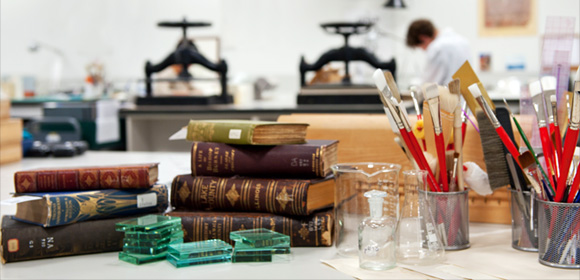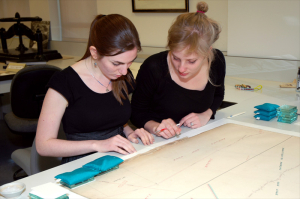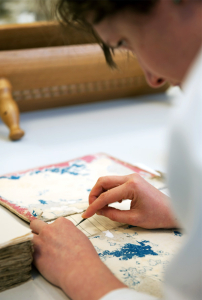
The Huntington Library and Scripps College students preserve the future of a profession
Scripps College junior Dinah Parker developed a love for art while restoring antiques at her family’s business. But her best grades were in science, so when it came to choosing a major, she was considering chemistry or pre-med. There was one problem. Science alone didn’t satisfy her artistic passions.
Then one day her roommate told her about a new undergraduate major, in art conservation. “It was perfect,” recalls Parker. “It required the science courses I’m good at plus the art courses I love.”

Robin Dubin and Dinah Parker examine tears at the edge of a 19th-century map from The Huntington’s collection. Photo by Lisa Blackburn.
Before Scripps—a woman’s college in Claremont, Calif.—began developing its new art conservation major, The Huntington’s library conservation department had undergone its own evolution, complete with a new, state-of-the-art lab. Safeguarding the Library’s more than 8 million rare books, manuscripts, prints, photographs, maps, and other materials is a growing challenge. Seven years ago, the conservation team moved from the two tight rooms into which they had once squeezed to a 10,000-square-foot space in the Munger Research Center outfitted with sophisticated equipment and bathed in natural light. Today, it houses not only standard book and paper conservation equipment like high-powered light microscopes, suction tables, and book presses, but also more sophisticated equipment found in only few labs nationwide. Their leaf caster, a high-tech device that gently assists in the repair of sheets of paper eaten away by mold, pests, or just plain age, is a conservator’s dream. The lab also boasts a built-to-spec light-bleaching system that irradiates paper with ultra-bright light to remove stains.
“We’re not the kinds of interns who only wash brushes and strain paste. We’re actually entrusted to touch things.” Last year, these two developments—Scripps’ new major and The Huntington’s state-of-the-art lab—converged. The Scripps’ undergraduate art conservation major is one of only a select few in the nation. Typically, students find out about the field late in their academic careers and play catch-up trying to fulfill the prerequisites for graduate school. The new major streamlines that path by requiring students to complete all the prerequisites, such as general and organic chemistry, art history, and studio art. And it includes an internship so students can learn hands-on skills and begin assembling a portfolio.
“Grad schools require hundreds of hours of bench work before students can even apply,” says Mary MacNaughton, Scripps associate professor of art history and director of the college’s Ruth Chandler Williamson Gallery. “But it’s a catch-22. Without the degree, it’s hard to get the opportunities, “she says. So MacNaughton started researching conservation labs that could host her students.
Around the same time, Holly Moore, The Huntington’s Lloyd E. Cotsen Head of Conservation, was thinking about new ways to use the lab and its highly trained staff to expand on the two internships she had in place. The Andrew W. Mellon Foundation Fellowship in Conservation makes it possible for college grads intending to apply to conservation graduate programs to practice hand skills and develop a portfolio over a three-month period during the summer. Another program, the Advanced Internship for Conservation Graduate Students, helps graduate students in their final year of studies to refine their techniques and make more nuanced treatment decisions over an intense, 9- to 12-month period.

A conservator removes remnants of old end sheets from a book’s cover boards. Photo by Martha Benedict.
But few opportunities exist for undergraduate students to put theory into practice. If Moore could develop such a “pre-program” internship in conjunction with Scripps, it would be one of only a handful offered at institutions nationwide. She had the lab space, she had the equipment, and she had a staff of six, including several conservators from nationally and internationally recognized conservation programs. Could she make these precious resources available to some well-qualified undergraduates?
The answer came when Scripps’ MacNaughton called one day asking if she could bring a few of her students to tour The Huntington’s lab. Over a series of conversations, Moore and MacNaughton created the Scripps College Art Conservation Independent Study Internship. Each semester, one or two interns would spend a day each week at The Huntington. They would follow a demanding syllabus developed by The Huntington and approved by Scripps.
“I designed the syllabus thinking about what I would have wanted as a young student,” recounts Erin Jue, a paper conservator on staff. “Undergraduate interns need to be exposed to a broad range of treatments, but they also need to start thinking about grad schools.” Jue studied biochemistry/ molecular biology and art history at Berkeley and then earned a Master’s in Art Conservation from New York University.
This past January, Scripps students Dinah Parker and Robin Dubin began their 10-week internship. Initially, they were a bit intimidated at the thought of handling rare photos, drawings, and other fragile objects, says Jue. But two months later, as they stood at adjoining benches perched over some 19th- century maps of Los Angeles County, the initial jitters had all but faded as they confidently worked on the material with ease.
The maps were from a collection of more than 360 recently donated to The Huntington. Hand drawn between 1860 and 1895, they are a telling example of preservation’s importance. Showing roads, land ownership, buildings, geographical features, and waterways, the maps provide valuable insights into the development of Los Angeles County before, during, and after the boom of the 1880s. But after years of use by the Los Angeles County Assessor’s Office, they were brittle, covered with grime, and riddled with small tears. Without intervention, they would be too fragile to use.
Before the interns began, The Huntington’s paper conservators took the maps out of their bindings. To help remove the heavy creasing, they gently introduced moisture by humidifying them in giant containers and then flattened them between sheets of felt. The interns removed surface dirt using a dry cleaning method employing grated eraser “crumbs.” The interns then got the chance to humidify and flatten smaller areas on the maps that remained creased. For this task, they turned to a fabric used by sportswear manufacturers—waterproof, breathable Gore-Tex.
Water can be a conservator’s friend or foe. When used correctly, it helps to loosen folds and wrinkles. But if uncontrolled, water can, of course, weaken, stain, and destroy paper. Gore-Tex is permeable in only one direction, and it releases water in vapor form. By creating a Gore-Tex package, the interns controlled the flow of water, easing away creases.
Then the interns stabilized tears at the maps’ edges. Working slowly and methodically, they re-adhered loose fragments to the underlying fabric support using wheat-starch paste. To repair any tears, they added pieces of conservation-grade Japanese tissue paper, which is thin and flexible but has strong, long fibers. “Robin loves tear repair,” teased Parker. “It makes such a dramatic difference,” agreed Dubin. “The maps were falling apart. Now they look better, and I can see the difference I’m making.”
In addition to repairing two of the Los Angeles County assessor’s maps, they also worked on photos from early 20th-century Los Angeles and placed early architectural drawings of the Huntington mansion into Mylar sleeves.
“We’ve been incredibly lucky,” says Dubin. “We’re not the kinds of interns who only wash brushes and strain paste. We’re actually entrusted to touch things.” Moore agrees that giving college students such open access is rare. “Undergraduate programs for conservation were practically nonexistent when I was preparing to apply to graduate schools,” she said, “so I had to find an internship without the backing of a college or university. It made the process much more difficult.” Just as crucial for Dubin and Parker was their exposure to Huntington staff members who served as mentors. Tips on repairing a frayed manuscript came between recollections about graduate programs and classes and descriptions of the close-knit community and intense camaraderie that awaits the students pursuing careers in preservation. “Grad school is such a defining moment in one’s career,” said Jue. “Not only do you develop relationships with other conservation professionals and conservation educators, but you also meet some of your best friends and people who are bound to become life-long colleagues.”
Shortly after the Scripps students started, Moore launched one more internship, partnering with UCLA to host students from its library and information studies master’s program (see sidebar). All the while, The Huntington remains a dynamic collecting institution, having added more than 100,000 rare books, manuscripts, photos, and other objects over the last few years alone. As collections come in, fragile and worn items pass through the lab for evaluation and conservation. Moreover, every time The Huntington mounts an exhibition, the conservators must examine and conserve the objects going on display beforehand. All of this activity points to a growing demand for conservation, says Moore, who is quick to point out that a vital internship program is part of her program’s dynamism.
As for Parker and Dubin, they have since returned to the classroom full time, studying art conservation theory with a better understanding of what it means in practice.
This article originally ran in the Spring/Summer 2011 issue of Huntington Frontiers magazine and is reprinted here with permission.

